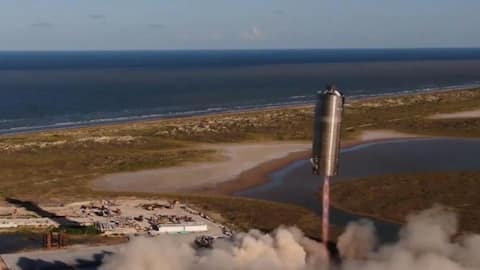SpaceX's Starship prototype flies, lands for the first time
What's the story
After months of pressure tests and development efforts, the prototype of SpaceX's Starship deep-space rocket has gotten off the ground.
The vehicle, called Starship SN5, flew for the first time, went up to an altitude of 500 feet, and then landed back vertically on the ground - all without a hitch.
Here is all you need to know about this quick 'short hop'.
Flight
Short hop with first large scale prototype
Last year, SpaceX's "Starhopper" performed a quick flight into the air but that was an undeveloped mini version.
This time, the Elon Musk-led spacefaring company has flown a larger-scale prototype, making it the biggest version of Starship ever to be tested.
The vehicle went up from SpaceX's launch pad in Boca Chica, Texas, and then made a slow, controlled descent after a few seconds.
Details
Prototype only used one raptor engine, didn't have nose cone
During the short flight, which you can stream on SpaceX's YouTube channel, the SN5 prototype used one Raptor engine (also used in Falcon 9 rockets) to fly up to 150 meters.
The vehicle did not even have a nose cone and used a weighted block on its head to simulate its mass during the flight.
Overall, it looked more like a flying water tank.
Plan
More short hops to be performed: Musk
Following the success of the flight, Musk tweeted out that they will conduct more such short hops with Starship prototypes (presumably this one and already prepared SN6) to perfect vertical lift-off and landing capabilities of the vehicle.
"We'll do several short hops to smooth out launch process, then go high altitude with body flaps (attached)," the billionaire said in the tweet.
Milestone
Either way, this is a major milestone in Starship development
While it remains unclear when the short hops or the higher altitude flight would take place, the latest development is certainly a major milestone in Starship development.
SpaceX has been developing and testing prototypes of the vehicle pretty quickly but has had little success lately.
Prior to this flight, at least four of the company's prototypes had exploded or imploded during ground tests.
Goal
Eventually, Starship will go to Moon, Mars
The work on Starship is moving forward with the ultimate goal of developing it into a vehicle that could take humans to Moon, Mars.
The short hops, long hops, and orbital flights with Starship prototypes will help SpaceX create the final version of the spacecraft, which will stand nearly 160 feet tall and fly cargo/humans weighing up to 100 tons at hypersonic speeds.
Information
Final version will have more Raptor engines
The final Starship, when combined with its 'Super Heavy' booster, will have 37 Raptor engines, producing a thrust of 11 million pounds at lift-off from the ground. That vehicle could also be used for high-speed point-to-point travel around Earth, SpaceX has proposed.
